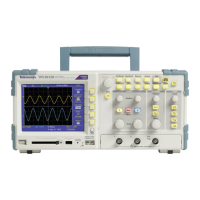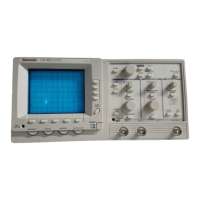Reference
Force Trig Butt
on. Use the Force Trig button to complete the current waveform
acquisition whether or not the oscilloscope detects a trigger. This is useful
for Single a cquisitions and Normal trigger mode. (In Auto trigger mode, the
oscilloscope automatically forces triggers periodically if it does not detect a
trigger.)
Trig View bu
tton. Use the Trig View mode to display the conditioned trigger
signal on the oscilloscope. You can use this mode to see the following types of
information:
Effects of the Trigger Coupling option
Signal co
nnected to the Ext Trig BNC
NOTE. This is the only button that you must hold down to use. When you hold
down the
Trig V iew button, the only other button you can use is the
print
button. The oscilloscope disables a ll other front-panel buttons. The knobs
continue to be active.
Trigger Holdoff. You can use the Trigger Holdoff function to produce a stable
display of complex waveforms, such as pulse trains. Holdoff is the time between
when t
he oscilloscope detects one trigger and when it is ready to detect another.
The oscilloscope will not trigger during the holdoff time. For a pulse train, you
can adjust the holdoff time so the oscilloscope triggers only on the first pulse in
the train.
To use Trigger Holdoff, push the Horiz ► Set Trigger Holdoff option button
and use the multipurpose k nob to adjust the holdoff. The resolution of the trigger
h
oldoff varies depending on the Horizontal Scale setting.
TPS2000B Series Digital Oscilloscope User Manual 117

